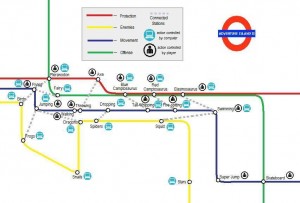The videogame theorist Alexander Galloway suggests that “if photographs are images, and films are moving images, then videogames are actions” (Gaming: Essays on Algorithmic Culture, p. 2). To be more precise, videogames represent actions across space and time. And as Galloway points out, these actions occur both in-game and out-of-game, enacted by both the player and the machine. If all this is true, then it should be possible to map the actions of a videogame in a visual way. For this inquiry you will explore how player or machine actions occur across space and time in a single videogame, building a kind of model that highlights selected actions of the game in a non-textual manner. Your object of study will be an NES (Nintendo Entertainment System) game. The inquiry is due in class on Tuesday, March 2.
- Select a game. There are three routes to finding and playing a game for this assignment. The first, more robust method is to download the NES emulator Nestopia. There are Mac and PC versions available. After you have installed Nestopia, you can find many classic Nintendo ROMs at the Old Computer Room. The advantage to this method is that Nestopia allows you to save “films” of your games and capture screenshots, which could both be useful for this assignment. The second method is to play online at Virtual NES. This site has hundreds of NES games that you can play in your browser via Java. Finally, if you have access to a Nintendo Wii, you can use the Wii Virtual Console to download classic NES games. If you don’t know which game to choose, sample some of the games reviewed in one blogger’s list of The 100 Best NES Games Ever. Try to select a “rich” game for this inquiry, by which I mean a game that is more textured or complex than Space Invaders or Frogger.
- Play the game. Play the game thoroughly and thoughtfully, paying attention to both the central and peripheral actions of the game. Keep in mind Galloway’s theory of four gamic actions. It’s easy to focus on the diegetic operator acts (what the player does in-game), but don’t overlook the other three realms of gamic action. Also consider the game’s representation of space and time. How is space structured in the game? How is time conveyed in the game? What different actions are available to the player as gameplay unfolds?
- Map an aspect the game. A “map” does not necessarily have to be a cartographic map; in fact, the last thing I want is a map of all the “places” in the game. Rather, by “map” I mean a visual model of some slice of the game that captures the complexity of the gamic action. There are a number of ways to approach this. You could, for example, overlay diagrams onto several screenshots of the game. You could create a timeline that depicts events across several minutes of intense gameplay. You could create a flowchart or branching diagram that documents the player’s action across a length of time. You could design a Venn diagram that shows the intersection between certain player actions and specific times or spaces. For other ideas, see the Periodic Table of Visualization Methods. I encourage you to be creative and to make use of any style or tool necessary. You can be as low-tech or high-tech as you want; your map can be hand-constructed or you can use sophisticated concept-mapping software like CMap.
- Explain the map. All maps have a legend or some other annotation that elucidates the information represented. Include a key on the map that helps the viewer make sense of what is represented.
- Reflect. In roughly three pages, reflect on the aspect of gamic action that you were trying to convey. What was it that drew you to this element of the game? Why did you “map” this element the way you did? What does your map reveal about the game that a casual playing of the game would not? How do your findings align with Galloway’s theories about the four moments of gamic action? In what ways does your map succeed? What are its limitations? And finally, what was the experience like of trying to represent in a static visual form something that is dynamic and dependent upon action?

